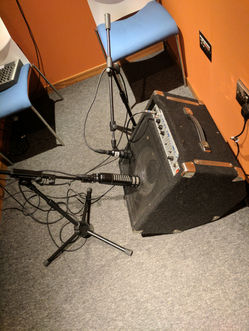JOSEPH COOKLIN LEVEY - UNIT:7B
I'm A Blind Man - Post 2
R&D
Over the last year and a half at Northbrook we have been testing out different microphones, for many different applications, on many studio sessions. So we chose microphones that from previous experience had given us the best results. For example: I am mad about the MD421, which we used on each of the rack toms. They have a wide frequency response and has extremely pronounced directivity. For use on the Toms we placed them so they are pointing just over the top of the drum head, capturing not just the hit of tom but all the decay, sustain and “after-air”.
Also the Neumann U87 on vocals… who wouldn’t? I’ve never had anything but fantastic results from this microphone. Stepping it up by routing via a Neve 8801 channel strip made the vocal take sound like an angel.
We did do a little “on the fly” research. During sound check we tried out a few different guitar amp mics and experiment with positioning. Reason being, we couldn’t record multiple guitar amp mics because we had run out of channels and could only spare 1. So we listened to the SM57, E609, C1000 and my own Sontronics Halo mic. And what we found was the super cardioid polar pattern and body of the E609 best captured the performance of the Fender DeVille guitar amplifier.
Tracking went fantastically. The band were impressed that we had managed to suss out a way of patching the channel lines out via auxiliaries 1-4 on the TLAudio console, and then feeding them to 4 independent headphone amps. Its simple enough when the control room is configured in that way but we had use some back routes to get there and ultimately, we ended up with happy musicians. Happy musicians give a better performance.
In our bid to gain as much isolation control as I could for post production, I did some researched. It’s mostly common sense (design live room so microphones are pointing away from foreign sound sources. Use obstacles to absorb/defuse unwanted live room sound), but I found an interesting article that discussed the method of re-amping signals. As the band wanted to play together (3 musicians in one live room and a vocalist in a booth), we needed a way of gaining clarity between each microphone in what was a very noisy room. We placed a 3 iso boards around the drum kick (being sure not to intrude on the line of sign), one between the drum kick and the guitar amp (with the guitar amps super-cardioid E609 facing away) and with the bass going straight into a DI. And it’s that bass DI that we would later re-amp under more isolated conditions at a further date. Bass bleed is extremely difficult to get rid of and post recording re-amping completely cleared the rest of the live room microphones. This process also meant we could tinker with the bass amp and spend more time working on capturing the best sound without the band waiting around for us. We are enablers.
When the band played the take that I used for this submission I couldn't get the thought of Pink Floyd or some sort of rock organ playing. The 4 piece band consisted of a drummer, guitarist, bassist and a vocalist… no keys player. I also didn’t know the original song, or who wrote it or the tracks original instrumental (turns out the original by Deep Purple has an organ). During the later stages of development I learnt and performed an organ track that I layered on top of the track. I like that I thought the bands cover needed an organ before hearing the original had one… bit of a producer ego boost.


